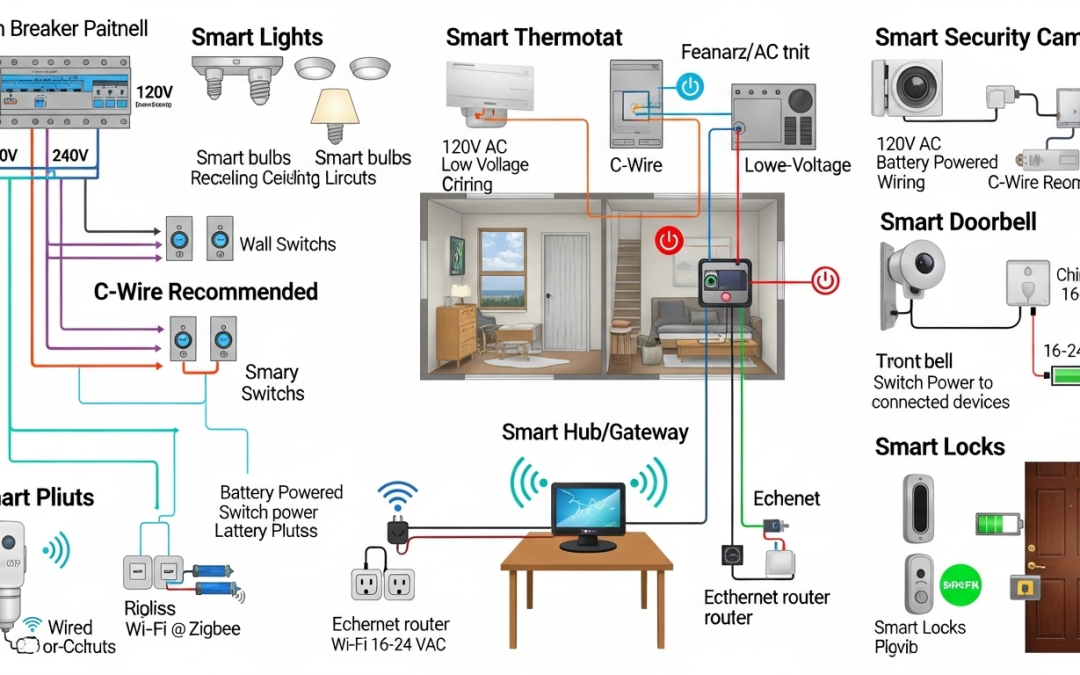Preparing your home for smart technology is an exhilarating endeavor; however, prior to replacing every bulb and switch, it is essential to comprehend the electrical infrastructure that supports it all. Although numerous smart devices are straightforward to use by merely plugging them in, some necessitate particular wiring to operate safely and effectively.
The Power Behind the Tech: Understanding Your Electrical Needs
At its essence, a smart home depends on a reliable and adequate power supply. The majority of residences function on a conventional 240-volt electrical system, which is sufficient for typical household devices. Nevertheless, the specific requirements of a device are dictated by its type:
- Plug-and-Play Devices: These devices are the simplest to install. Consider smart speakers, Wi-Fi cameras that come with a standard power adapter, or smart plugs. They merely connect to a standard wall outlet and do not necessitate any specialized wiring.
- Hard-Wired Devices: This category requires the expertise of an electrician. Devices such as smart switches, certain security systems, and high-power appliances must be directly integrated into your home’s electrical system. This guarantees a permanent, dependable, and safe connection.
Common Smart Devices and Their Wiring Nuances
Smart Lighting
This is often the first step for many people. You have two main options:
- Smart Bulbs: These are the most straightforward option. You simply screw them into your current light socket. They utilize the existing power and connect to your home network through Wi-Fi or Bluetooth.
- Smart Switches: This is a favored option for managing entire rooms of lighting. The primary electrical requirement in this case is the neutral wire. A neutral wire is crucial for a smart switch to maintain a continuous power supply, enabling it to remain “on” and communicate with your network, even when the light is switched “off.” Many older residences may lack a neutral wire in the switch box, necessitating the assistance of an electrician for installation.
High-Power Smart Appliances
Devices that consume significant amounts of electricity, such as smart air conditioners, tankless water heaters, or electric vehicle (EV) chargers, necessitate careful consideration. They cannot be connected directly to a conventional wall outlet. These appliances require:
-
Dedicated Circuits: A dedicated circuit refers to an appliance that is equipped with its own circuit breaker located in your main electrical panel. This arrangement safeguards against the risk of overloading a shared circuit, which may lead to tripping the breaker or creating a fire hazard.
-
Higher Amperage: Appliances that consume a significant amount of power typically necessitate a circuit with a higher amperage rating (e.g., 20A, 30A, or greater) to effectively manage the electrical load.
Smart Security Systems
Although numerous security cameras operate on low voltage and can utilize a basic USB adapter, a complete security system may necessitate professional wiring to ensure a neat and dependable installation. This process involves routing power and data cables through walls to essential locations.
The Role of a Professional
Although it may be appealing to undertake some of these installations yourself, particularly given the plethora of online tutorials available, it is essential to recognize when it is necessary to engage a professional. A skilled electrician does more than merely connect wires; they guarantee that your entire electrical system is capable of handling the demands placed upon it. They are able to:
- Confirm that your circuits are capable of managing the increased load.
- Correctly install neutral wires in the necessary locations.
- Safely set up dedicated, high-amperage circuits for substantial appliances.
- Make certain that all wiring adheres to safety regulations, safeguarding you and your residence from possible dangers.
By comprehending the power needs of your smart devices, you can create a system that is not only convenient but also secure and dependable for many years ahead.
Conclusion
Transforming your house into a smart home isn’t just about choosing the latest gadgets—it’s about making sure your electrical system can support them safely and efficiently. From plug-and-play devices to high-power appliances, every smart upgrade comes with its own wiring and power needs. By planning ahead, using the right circuits, and relying on licensed electricians when necessary, you’ll create a home that’s not only smarter but also safer, more reliable, and ready for future technologies.

